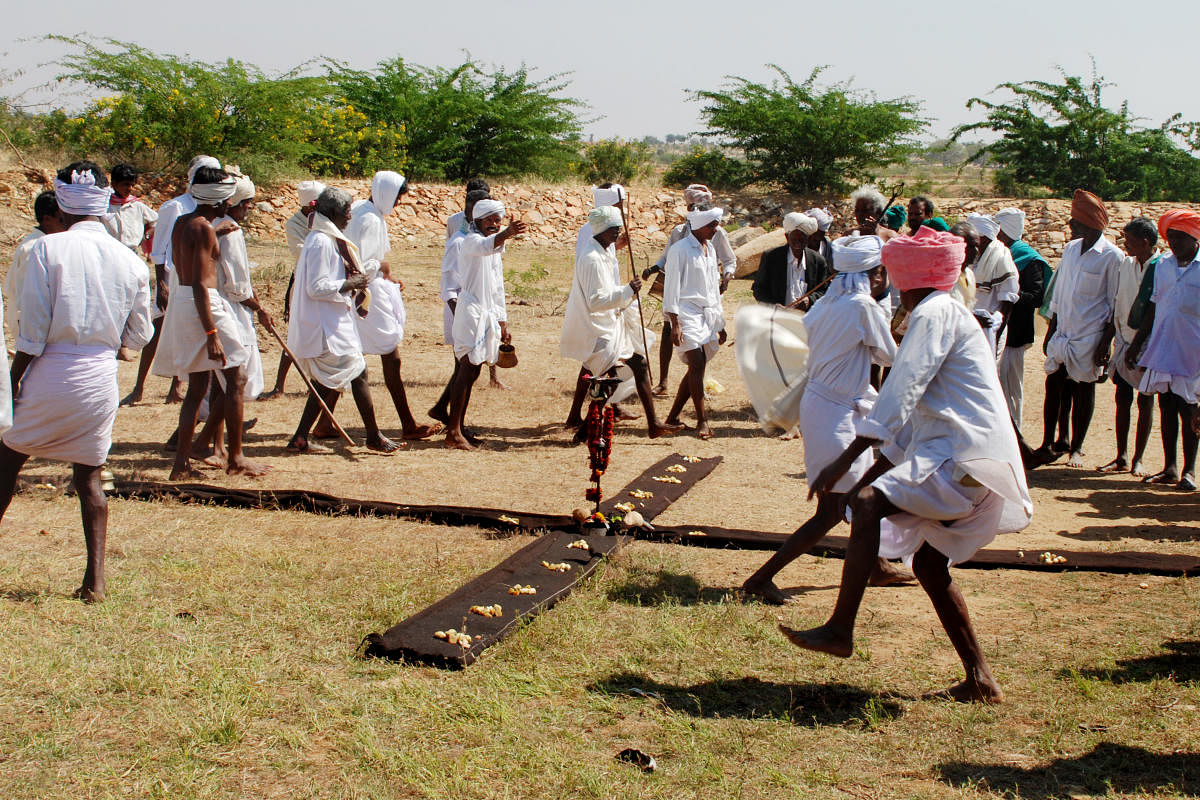A Sankranthi fair in harmony with nature



Spread across the plains of central Karnataka (Bayalu Seeme), the indigenous Kadugolla community has kept its distinct culture alive and is passing it on to the younger generation. The Kadugolla community members were traditionally hunters and cattle herders but now engage in agricultural activities also.
Their fairs, celebrated with pomp and gaiety, mirror their age-old culture. One such fair celebrated by the Kadugollas is the Kyathappana jathre (fair), dedicated to their deity, Kyathappa.
This fair is celebrated annually for 15 days, either before or after the Sankranthi festival.
Different fairs are held at different places and this one is held at the kavals (grazing fields) of Vasaludibba and Purlahalli near Channammanagathihalli, in Challakere taluk, Davanagere district.
People from 13 groups of the community who have traditionally vowed to worship the deity, get together to take part in the fair.
Traditionally, Konanagowdar and Bommanagowdar (two sub-groups) look after the rituals. While the Bommanagowdars install the kalasa atop the shack (temple), five Iragaararu (youths) from the Konanagowdars uninstall the kalasa at the end of the fair.
Those observing the batha (vrutha) of the Kyathappana jathre are supposed to observe certain rituals.
The batha concludes after cooked horse gram is offered to the deity at the Kyathappa temple in Channammanagathihalli. Later it is served to the devotees. On the same day, Hurulithokku (horse gram dish) and Bellada Haalu (jaggery milk) is prepared at the homes and is served among the relatives.
On the fourth day of the fair, the men fetch the wood for building a shack (which serves as a make-shift temple). The grazing field where the Kyathappa temple has to be built is cleared and cleaned. On the fifth day, thorns from a variety of plants and leaves are cut and gathered. On the sixth day, they draw the fence line around the temple.
On the seventh day, they dump the thorns and leaves at the temple venue. On the eighth day, they install the stump of a banyan tree which acts as a base and build a 20 to 25 feet tall structure (temple) on it using thorns. In the evening, they install a metal kalasa on top. A thorny fence is then drawn around this temple. Then, they get deities like the Katumlinga, Veerana devaru, Bathuvina devaru and Tali devaru.
On the ninth day, members of the 13 sub-groups take these deities to a holy pond.
They then return to the makeshift temple in a musical procession. They offer Ganga puja at a well (known as Akkagala Bhavi) and then tie kankana (holy thread) to the deities. These deities are formally installed in the makeshift temple (Kalle Gudi) after this.
For the next three days, they worship ant mounds, cattle grazing land, the well and other natural elements while feasting on millet dishes.
The most awaited day of the fair is the 13th day when the kalasa has to be uninstalled. Five Konanagowdars youths are taken to the well in a procession and are given a bath. They then sit before the deities and are showered with flowers. As soon as a veteran of the community waves a piece of cloth hung on his shoulder, these youths climb the ‘temple of thorns’ in competition and within a moment, the one who climbs first swiftly takes off the kalasa and displays it to the people present there.
After the kalasa is taken off, the deities are brought out of the temple and are taken around Channammanagathihalli in a procession and then taken to Purlahalli. The next day, the kankana is untied at the temple at Channammanagathihalli after a feast of horse gram is prepared to signal the conclusion of the fair.
All the rituals associated with this fair, indicate that the life and beliefs of the Kadugolla community are connected with nature.
(Translated by Divyashri Mudakavi)